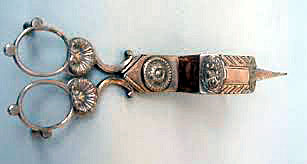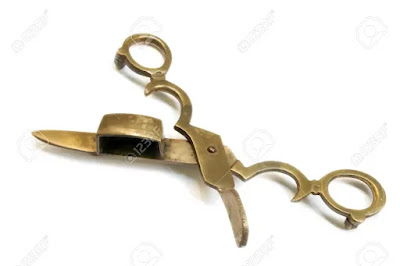 QUESTION: Ever since I was a little girl having tea parties for myself and my dollies, I’ve loved little cups and saucers. One of my grandmothers gave me a little tea set for my sixth birthday. I loved that set. Soon my tea parties expanded as I invited my girlfriends to bring their dollies over to visit. As I got older, my interests changed until one day while helping my mother clean our attic, I found my original miniature tea set. Since then, I’ve been collecting miniature cups and saucers. I would love to enhance my collection. Can you advise me on how to do that?
QUESTION: Ever since I was a little girl having tea parties for myself and my dollies, I’ve loved little cups and saucers. One of my grandmothers gave me a little tea set for my sixth birthday. I loved that set. Soon my tea parties expanded as I invited my girlfriends to bring their dollies over to visit. As I got older, my interests changed until one day while helping my mother clean our attic, I found my original miniature tea set. Since then, I’ve been collecting miniature cups and saucers. I would love to enhance my collection. Can you advise me on how to do that?
 ANSWER: What a charming memory. Collecting miniature cups and saucers and even whole tea sets has been a popular pastime for many people. The chief advantage is that because they’re small, they take up less space, making them ideal for those living in condos and apartments.
ANSWER: What a charming memory. Collecting miniature cups and saucers and even whole tea sets has been a popular pastime for many people. The chief advantage is that because they’re small, they take up less space, making them ideal for those living in condos and apartments.
Children’s tea sets, first produced for the children of the wealthy, seem to have been created before potters discovered the formula for porcelain in Europe. Metalsmiths crafted the earliest ones of pewter or copper, and in some cases gold or silver. Children’s toy tea sets first appeared in 16th-century Germany, a country known for producing toys in wood and metal.
 Porcelain children’s tea sets didn’t appear until the 18th century, but just like the silver and gold ones, only the wealthy could afford them. These sets were generally of very high quality, and people kept them for special occasions. Children’s tea sets didn’t become popular household items until the early to mid 19th century, during the Industrial Revolution. The Universal Exhibition of 1855 in London seems to have been the starting point of their expansion.
Porcelain children’s tea sets didn’t appear until the 18th century, but just like the silver and gold ones, only the wealthy could afford them. These sets were generally of very high quality, and people kept them for special occasions. Children’s tea sets didn’t become popular household items until the early to mid 19th century, during the Industrial Revolution. The Universal Exhibition of 1855 in London seems to have been the starting point of their expansion.
In Colonial America, tea was a family event, with everyone enjoying a break during the day. No doubt make-believe tea time and pretend tea drinking were a part of some children’s playtime activities. Perhaps many little girls played at serving tea and dreamed of having a tea parties of their own. The pieces in these sets usually imitated those in regular sets, differing only in size. Though children’s cups and saucers look like traditional tea cups, only a bit smaller than demitasse cups. The handles were small, and not easy for adult hands to hold.
 Collectors love miniature cups and saucers for their variety, in shape, style, and decoration. They can be classified in two distinct styles—dollhouse-size miniatures and toy-size.
Collectors love miniature cups and saucers for their variety, in shape, style, and decoration. They can be classified in two distinct styles—dollhouse-size miniatures and toy-size.
Dollhouse-size miniatures are the smallest—usually scaled an inch to the foot. During the late 18th century, English and continental makers produced dinnerware sets for fashionable ladies to furnish miniature rooms in large dollhouses. By the 19th century many more companies produced these sets, making them for both children's and adults' dollhouses.
 During the Victorian era, wealthy families furnished a nursery for their children. While adults took tea in the parlor, the children had theirs in the nursery. This practice required child-size tea sets. Teacups held three or four ounces, just the right size for three-year- and up. Manufacturers decorated these pieces with animal themes, nursery rhymes, airy .tales, children's activities and the art of famous illustrators
During the Victorian era, wealthy families furnished a nursery for their children. While adults took tea in the parlor, the children had theirs in the nursery. This practice required child-size tea sets. Teacups held three or four ounces, just the right size for three-year- and up. Manufacturers decorated these pieces with animal themes, nursery rhymes, airy .tales, children's activities and the art of famous illustrators
 First made n the early 19th century, Staffordshire ABC ware included more than 700 patterns. The alphabet appears on each piece. In the case of a small one, such as a tea cup, which was too small for the entire alphabet to fit, English manufacturers made the letters smaller or used fewer of them. Today, children's size miniatures are the most abundant and reasonably priced. American production of children's ware reached a peak during World War II before the less costly Japanese ware became available.
First made n the early 19th century, Staffordshire ABC ware included more than 700 patterns. The alphabet appears on each piece. In the case of a small one, such as a tea cup, which was too small for the entire alphabet to fit, English manufacturers made the letters smaller or used fewer of them. Today, children's size miniatures are the most abundant and reasonably priced. American production of children's ware reached a peak during World War II before the less costly Japanese ware became available.
Mary of Teck, wife of George V of Great Britain, who reigned from 1910 to 1936, was an avid collector of dollhouses and miniatures. Because of her interest, the hobby regained popularity in the 1930s through the 1950s, making early dollhouse-size miniatures rare.
 Toy-size miniatures are larger than the dollhouse-size but smaller than child's size. Novice collectors often mistake them for salesman's samples. These toy-size miniatures served several purposes. First, collectors could display them in a cabinet. Second, they taught children of wealthy families manners and social races in the late 18th and 19th centuries. Makers frequently decorated these teacups and saucers with historical scenes and mottoes.
Toy-size miniatures are larger than the dollhouse-size but smaller than child's size. Novice collectors often mistake them for salesman's samples. These toy-size miniatures served several purposes. First, collectors could display them in a cabinet. Second, they taught children of wealthy families manners and social races in the late 18th and 19th centuries. Makers frequently decorated these teacups and saucers with historical scenes and mottoes.
 Manufacturers produced these toy-size cups and saucers in the same forms, shapes and styles as the full-sized ones of the period. The potters of Nuremberg, Germany became famous for their miniature tea sets, decorated in vivid colors. Early tea bowls and saucers made by Meissen occasionally come up for sale. The Dutch produced small pottery items decorated in blue and white in the 17th century and introduced them to England in the 1690s. Soon "baby house waresº were part of Staffordshire potteries’ stock.
Manufacturers produced these toy-size cups and saucers in the same forms, shapes and styles as the full-sized ones of the period. The potters of Nuremberg, Germany became famous for their miniature tea sets, decorated in vivid colors. Early tea bowls and saucers made by Meissen occasionally come up for sale. The Dutch produced small pottery items decorated in blue and white in the 17th century and introduced them to England in the 1690s. Soon "baby house waresº were part of Staffordshire potteries’ stock.
Companies such as Coalport, Minton, Spode and Worcester produced miniature creamware, stoneware and porcelain cups and saucers in the 19th century. The Dresden studios decorated miniature cups and saucers, often in the popular quatrefoil shape, in the late 19th century.
 The most common examples of toy size cups and saucers found in the marketplace today date from the 20th century. In France several companies in the Limoges area produced them around the turn of the 20th century and still make them today. RS Prussia manufactured examples of lovely molded cups with leafy feet and unusual shaped handles around 1900. English potteries, such as Shelley, Crown Staffordshire, Copeland Spode, Wedgwood, Royal Crown Derby, and Coalport miniature tea sets with trays, which were exact replicas of full-size sets. Collectors especially like the Royal Crown Derby pieces, decorated in the Imari patterns. Probably the hottest miniature cup and saucer in the marketplace today are those made by Shelley. The price for a cup and saucer can reach as high as $250 to $300. In the United States, Leneige Company and Gort China made miniature cups and saucers from 1930 to the 1950s.
The most common examples of toy size cups and saucers found in the marketplace today date from the 20th century. In France several companies in the Limoges area produced them around the turn of the 20th century and still make them today. RS Prussia manufactured examples of lovely molded cups with leafy feet and unusual shaped handles around 1900. English potteries, such as Shelley, Crown Staffordshire, Copeland Spode, Wedgwood, Royal Crown Derby, and Coalport miniature tea sets with trays, which were exact replicas of full-size sets. Collectors especially like the Royal Crown Derby pieces, decorated in the Imari patterns. Probably the hottest miniature cup and saucer in the marketplace today are those made by Shelley. The price for a cup and saucer can reach as high as $250 to $300. In the United States, Leneige Company and Gort China made miniature cups and saucers from 1930 to the 1950s.
 The creation of early plastics and Bakelite in the late 19th century marked a huge change in children’s tea set design. Manufacturers still made them in porcelain and more durable stoneware, but plastic sets soon began to emerge. By the mid 20th century, plastic sets and sturdy stoneware became the norm.
The creation of early plastics and Bakelite in the late 19th century marked a huge change in children’s tea set design. Manufacturers still made them in porcelain and more durable stoneware, but plastic sets soon began to emerge. By the mid 20th century, plastic sets and sturdy stoneware became the norm.
To read more articles on antiques, please visit the Antiques Articles section of my Web site. And to stay up to the minute on antiques and collectibles, please join the over 30,000 readers by following my free online magazine, #TheAntiquesAlmanac. Learn more about old-time winter objects in the 2022/2023 Winter Holiday Edition, with the theme "Winter Memories," online now. And to read daily posts about unique objects from the past and their histories, like the #Antiques and More Collection on Facebook.





























